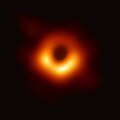This article requires sanitation. Particularly, it needs more accurate information, less vandalistic information, less biased information, and better formatting. (March 2022) |
| “ | Black holes are where God divided by zero. | ” |
— Albert Einstein
|
![]() Black holeballs are regions of spacetime where nothing, not even light, can escape. Some say that passing through causes time travel, or it leads to a Parallel Universe, or simply everything it eats is compressed to a tiny ball - but nobody knows. If the Big Freeze theory is true, it will be the only one left, if you don't count Dark Energy. Nobody knows how many of them there are (It's estimated to be Quadrillions in Observable Universe). When a starball large enough blows up, sometimes they become one in a supernova explosion.
Black holeballs are regions of spacetime where nothing, not even light, can escape. Some say that passing through causes time travel, or it leads to a Parallel Universe, or simply everything it eats is compressed to a tiny ball - but nobody knows. If the Big Freeze theory is true, it will be the only one left, if you don't count Dark Energy. Nobody knows how many of them there are (It's estimated to be Quadrillions in Observable Universe). When a starball large enough blows up, sometimes they become one in a supernova explosion.
There are even supermassive black holeballs. These black holeballs can be only found if you go to the center of a galaxy. They are formed when many black holeballs merge together.
Now some people questioned their existence, or whether they existed at all. But in April 2019, the first picture ever was taken, one of the biggest achievements in space history.
The biggest Black Holeball is Phoenix A*ball.
Composition
There is an accretion disk that has a jet through it. The jet contains atomic matter. On the top and bottom of the accretion disk is a coronavirus. The corona contains hot electrons. In the middle, there is a black hole through it. Black holeballs have an event horizon, the boundary which nothing can escape upon entering, making black holeballs the ultimate Anschlusser. Because information cannot be lost, some scientists theorize that black holeballs can into soft hair that trap the information. The black hole proper is the singularity in the absolute center of the black hole. According to mathematics, the singularity's size is zero, resulting in a density of infinity. However, this cannot happen in real life. Spinning black holeballs can into a ring singularity with zero thickness. Some say entering one will result in a wormhole ending in a white hole. Others say that Universeball reproduces inside black holeballs (in the inner horizon). Still others suggest that the singularity is a planck nugget, which plays by the rules.
Formation
Massive starballs, upon death, expand until they are ![]() red supergiants. Then they explode. The explosion is called a supernova. Then, the stars have a chance to become black holes or neutron stars.
red supergiants. Then they explode. The explosion is called a supernova. Then, the stars have a chance to become black holes or neutron stars.
Death
Black holesballs slowly lose their particles, which is called Hawking radiation. More massive black holeballs do this slower. Smaller black holeballs emit Hawking radiation faster. The process can take to uncountable years. The most massive supermassive black holeballs are estimated to live for over a googol years.
Sagittarius A*ball
Sagittarius A*ball is the supermassive black holeball at the center of ![]() Milky Wayspiral. It was discovered in 1974, and it has a mass equal to 4.6 million
Milky Wayspiral. It was discovered in 1974, and it has a mass equal to 4.6 million ![]() Sunballs. On May 12, 2022,
Sunballs. On May 12, 2022, ![]() Earthball imaged
Earthball imaged ![]() Sagittarius A*ball using the Event Horizon Telescope.
Sagittarius A*ball using the Event Horizon Telescope.
Gallery
-
-
-
-
An IRL image of M87ball's supermassive black hole
-
An IRL image of Sagittarius A*ball as taken by the Event Horizon Telescope




